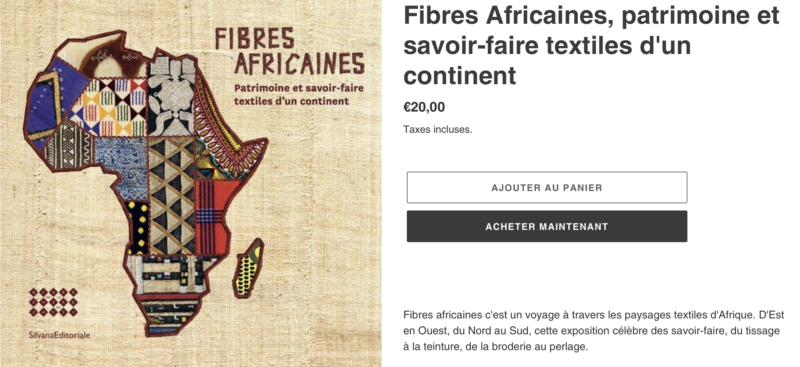Joyce Libakou, designer of the hair accessories brand ‘Laki’, had the opportunity to visit the African Fibres exhibition. In a podcast, she shares her feelings and the links she sees between her hairdressing practice and the exhibition.
« When I arrived and saw the ‘African Fibres’ sign with each fabric and each country, I thought it was beautiful. It’s well thought out, you start with the really old fabrics and go to the future and link the different fashions. In fact, I liked the work that was done behind it because there is a will to do things well. (…) And it just made me proud because I learned that there were fabrics like Ndop in Cameroon that were made locally and all that that implied: that it was a royal fabric so not everyone could wear it and I said to myself, yes, we have fabrics but we just don’t know it. »

Joyce, accompanied by our cultural mediator Danilo Lovisi, during the visit of the exhibition « African Fibres » at the Musée de la toile de Jouy.
« This heritage is hard to imagine that it can be valued, shown and shared, perhaps because people think that it is not necessarily valuable. We don’t necessarily meet professionals who show us that there is all this, and that’s what I find very sad. This kind of exhibition ‘African Fibres’ is what we should share with so many people so that they understand that, no matter where you come from: you have beautiful things to share and to show and that you have a culture. You just have a culture. »

« I am French, proud of my French side but very much oriented towards Africa. I am passionate about all things hair, the straight side, the curly side, but especially the Afro side which I think still lacks a positive image. That’s why I created my scarf brand called ‘Laki’. I really see a parallel with what is done at the exhibition in highlighting and enhancing the value of textiles because, in Laki, what I am trying to do and show is that hair, whether it is straight, curly or Afro, is beautiful. What is needed is simply to know how to take care of it and what is rather complicated and, this is where I see the common point with the loincloth is that, because of history, our hair has been badly perceived to the point where people who look like me refuse to wear it. Why do they refuse to wear it? Because they think it will be unprofessional, because they’ll get remarks. And there are some who also want to but don’t know how to do it because, in the end, I realise that we don’t know. »

You can also watch our previous videos « African Fibres in your home » on our Youtube channel, dedicated respectively to the Chemise Dress by Ly Dumas, created with a veil from Mauritania, and the NTSHAK fabric from the Democratic Republic of Congo.
While waiting to visit the exhibition, you can consult the exhibition catalogue, available in our e-shop.
